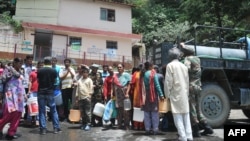As the vast Indian plains sizzle during the summer months, the picturesque hill resort of Shimla turns into a tourist haven. But after the Himalayan town’s water supplies virtually ran out, panicked residents sent out “Stop Visiting Shimla” social media posts, schools were temporarily shut, and authorities faced angry protests as people lined up to get meager supplies from water tankers.
Like other residents, Nilu Parmar faced a crisis since the problem erupted two weeks ago, even though she lives in an upmarket area that is usually spared the worst of Shimla’s water woes. “Even the tanker did not have enough water. So they were giving like three buckets per family,” she says.
The water crisis in the hill town, home to about 180,000 people, has eased slightly, although supplies are still strictly rationed. But it served as a wake up call for India, where sprawling metropolises such as New Delhi, Bengaluru and Mumbai routinely face critical water shortages as ground water levels deplete and lakes and rivers dry up.
Although Shimla is much smaller, comparisons were drawn to Cape Town, the South African city that faces the prospect of “Day Zero” when taps could run dry.
Chief Minister Jai Ram Thakur of Himachal Pradesh state, of which Shimla is the capital, blamed the water woes on meager snowfall and rainfall, which feeds mountain rivers and streams.
Others cited many more reasons for the chronic shortfall that has been steadily worsening: massive construction over the lush green slopes to accommodate the rush of tourists, an old water pipe system that results in leaks and unchecked extraction of ground water that is rapidly depleting water levels.
Experts also warned although the situation may not have reached Shimla’s proportion in other cities, they confront similar problems putting them also at risk of facing similar crises.The countryside is not much better off: women often walk for miles to fetch water in many areas.
“The trajectory we are on is of course one that is worrisome,” says Arunabha Ghosh, founder of the Council for Energy, Environment and Water in New Delhi. Citing India’s rapidly growing population and economy he points out that “while traditionally one would normally move from agriculture to industry to services, in India all these three sectors are growing simultaneously.”
While demand has grown enormously in a country of 1.3 billion people, experts also say India’s water woes are not as much due to scarcity as poor management of water sources and supplies.
Almost 70 percent of India’s population depends on groundwater for drinking and irrigation, but indiscriminate pumping over the past four decades has sent water plunging to dangerously low levels, warns Professor Abhijit Mukherjee, a hydrologist at the Indian Institute of Technology at Kharagpur, who has done several studies.
“I call it the largest extraction of ground water extracted in human history. If you look at the volume of water that has been extracted from India, it is more than the U.S. and China have taken out,” says the hydrologist.
Urban residents increasingly dig wells in their backyards to bypass unreliable municipal supplies. Farmers pump out water for their crops, even in areas close to rivers and streams because these are choked with urban and industrial waste and of little use in irrigating fields.
To underline the urgency of reviving the depleting water table, experts repeatedly point out that India has 18 percent of the world's population and four percent of its water resources. Some states like Gujarat and Andhra Pradesh have reported success after building recharge structures says Abhijit Mukherjee.
“They did small community level interventions, building small check dams, ponds, recharge canals.” But he warns that India has a small window in which to ensure that those in other parts of the country do not face the situation that Shimla residents coped with.
“Beg, borrow, steal: you do all sorts of things. You learn to have a bath in a basin and then throw that water in the flush,” says Nilu Parmar.











